Switching home lighting from FPL to LED
Posted by Wesley on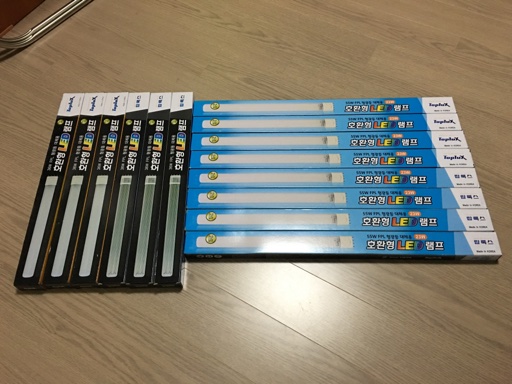
Fluorescent light replacement LED lamps from TopLux - 14 in all
Having a smart meter giving real-time power consumption data provided a lot of insights for my home. The baseline load when everything is idle is about 80W, and the refrigerator running at full power adds 90W to that. So when I noticed that more than 300W were being used during the evening hours even with the TV turned off, I had to track down what the culprit was.
It turned out that the sole reason for this uptick was the lighting. Fluorescent lights in the living room and the study room were turned on for several hours every day and contributing much to the total consumption. Knowing that LED lights were more efficient and that the price has come down a lot recently, I decided to make some major investment.
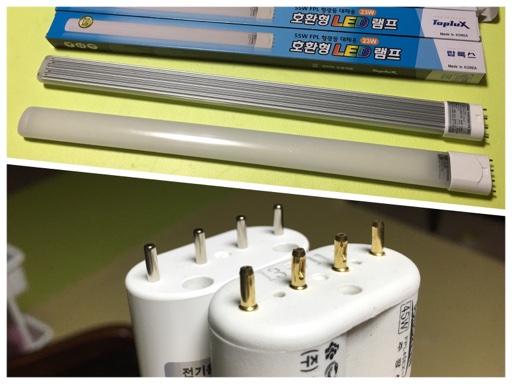
Front and back of the LED lamp / comparison of the connector (back: LED / front: FPL)
As with a lot of apartments in Korea, the typical type of lighting installed was PL compact fluorescent lights, or FPL for short. It uses 4-pin 2G11 socket and has external ballast. Lots of replacement methods exist - lamp-only, ballast + lamp (socket is kept), or total replacement. As the lamp-only method is simplest by far and not much more expensive than replacing everything, the choice was obvious for me. I ordered the relevant LED lamps manufactured and sold by TopLux of Korea which were on sale - 23W version cost about KRW 21,000 (US$17.50) and 15W one, KRW 14,000 (US$11.70). Here is how they stack up with the existing FPL lamps.
| Name | Type | Len. (mm) | Power (W) | Lum.Flux (lm) |
|---|---|---|---|---|
| Hyosun FPL45EX-D | FPL | 540 | 45 | 4060 |
| TopLux FT23-57 | LED | 535 | 23 | 3400 |
| Hyosun FPL32EX-D | FPL | 415 | 32 | 2600 |
| TopLux FT18W-04-57A | LED | 415 | 15 | 2250 |
According to the specifications, the LED lamp consumes about half the power while putting out about 85% of total light, or luminous flux, compared to the similarly sized FPL counterpart. This is indeed quite an increase in efficiency if it delivers. Visually, one side of the lamp is taken up by a long heat sink and uses the same four-pin layout. The pins themselves are simply round, not dimpled in the middle like the FPL it's replacing, so I suppose it won't "hook in" quite as well.
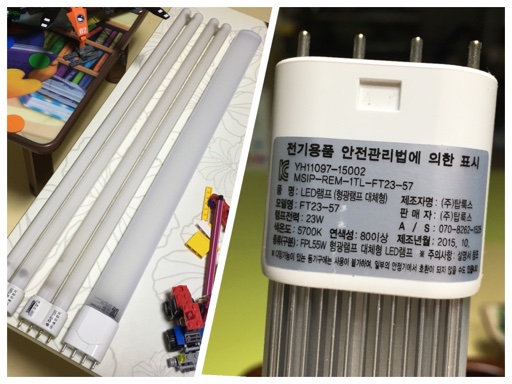
Comparison of the outward appearances / Product data label on the LED lamp
The round corners of the FPL lamp has more or less been duplicated in the LED one, facilitating the installation into the metal holder usually at the end of the light fixtures. Also, device safety certification and registration information displayed at one end gives a bit of peace of mind.
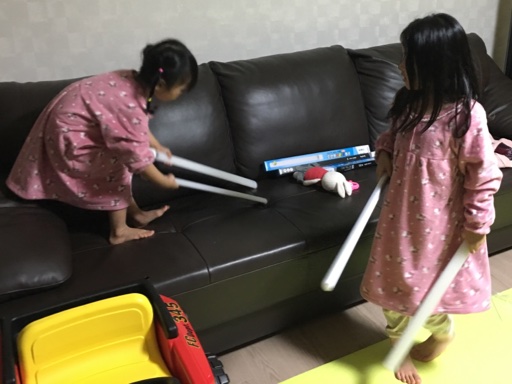
Kids have fun doing the lightsaber play with the lamps
When I got around to removing the cover of the fixtures to install the new lamps, the kids noticed what I was doing and immediately got into a light round of lightsaber fight with each other with them. The lights having survived this impromptu durability test, I resumed my work.
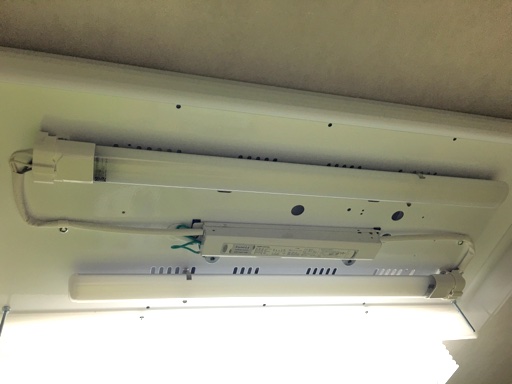
LED lamps installed into the FPL sockets without any modifications
As I didn't need to replace the socket or the ballast, the installation involved just removing the existing FPL lamp and putting the new LED lamp in. It was quite simple and quick, but as a precaution I wiggled the lamp a bit to make sure the pins were properly settled in. The lights turned back on mostly without issues. I did notice that a small buzzing sound was generated from the lamp.
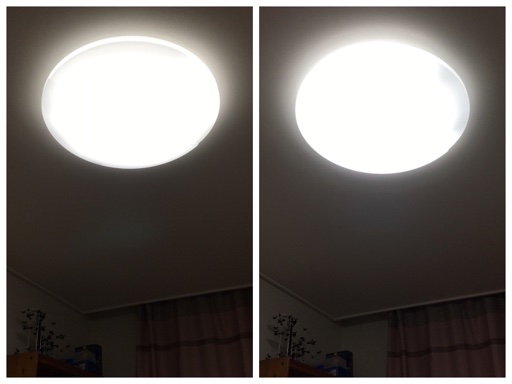
Brightness of one LED lamp (left) versus two FPL lamps (right)
The one striking thing I noticed about the LED lamps was how bright it seemed to look. This is compounded by the fact that the FPL lamps take a bit of time to get to full brightness. A single 15W LED lamp initially looked brighter than two 32W FPL lamps, and was only slightly dimmer after the FPL had time to fully brighten. So I decided to measure the brightness objectively using a smartphone app acting as a lux meter.
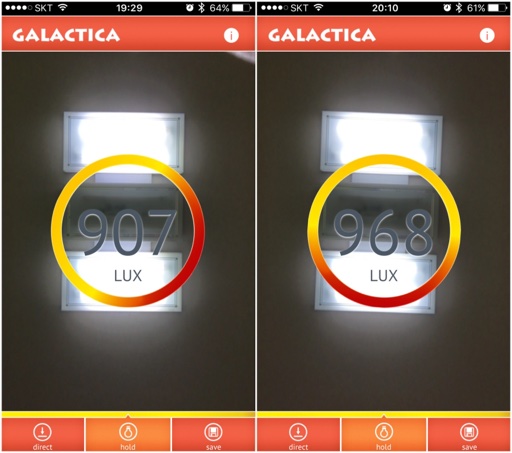
Comparing illuminance of the lamps using Galactica Luxmeter app: FPL (left) and LED (right)
There are several apps that claim to measure the illuminance with the built-in camera, so I downloaded six of them and did preliminary testing under various environments. Of those, half of them were relatively consistent and realistic. Eventually, I settled on Galactica Luxmeter to measure the before-and-after cases of the living room and the study room.
| Place | FPL (lux) | LED (lux) | Ratio |
|---|---|---|---|
| Living Room (45W x 4) |
907 | 968 | 106.7% |
| Study Room (32W x 3) |
363 | 454 | 125.1% |
When the same number of lamps were used under the same conditions, the LED lamps were indeed measured to be brighter. This confirmed my visual observations, but goes counter to the listed specifications. There are a couple of possible explanations for this discrepancy.
Most importantly, the FPL lamps were not new. I estimate that they were used for about 2,500 hours for the 45W ones in the living room and about 1,500 hours for the 32W ones in the study room. The lamps were certified to keep at least 80% of its original luminous flux after 2,000 hours, so this means that the actual value is likely to be similar to or slightly less than the new LED lamps' at this point in the lifecycle.
There's also the fact that the LED lamps direct all their light downwards, while the FPL ones radiate in all directions. This kind of focus means there may be less loss from reflection within the light fixture.
In any case, the fact that the LED lamps were able to keep up with the FPL counterpart remains. They should be at least nearly as bright even when comparing with new FPL lamps. Thus, they have proven themselves to be a proper replacement from the functionality point. Now let's move on to see if the advertised power consumption holds.
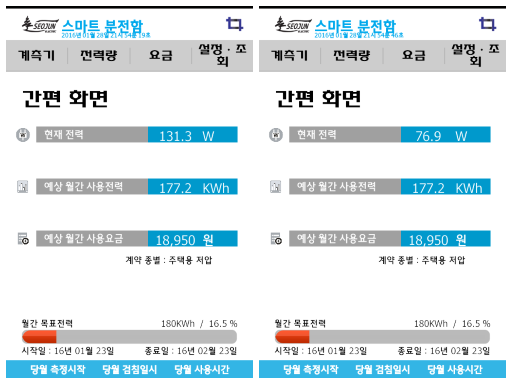
Measuring power consumption with Seojun smart meter: lights on (left) and off (right)
For this, I observed the differences in the reported power consumption from the smart meter as I turned the lights on and off. I was careful to make sure that other factors remained stable so as not to influence the measurements.
| Place | FPL (W) | LED (W) | Ratio |
|---|---|---|---|
| Living Room (45W x 4) |
169.9 (42.5/unit) |
94.6 (23.7/unit) |
55.7% |
| Study Room (32W x 3) |
92.7 (30.9/unit) |
54.4 (18.1/unit) |
58.7% |
The FPL lamps consumed slightly less (about 5%) than its rated levels, while the LED lamps consumed more, about 3% for the 23W one. This might be attributable to the ballast conversion loss. But the 15W one was actually needing 18W, which is about 20% more than expected. It seems that the actual power consumption level of this model is 17 to 18W (excluding conversion loss) and the model number reflects this (FT18W-04-57A) but apparently the manufacturer forgot to update the label accordingly.
Still, this represents over 40% savings of electricity compared to using FPL lamps in both types. Coupled with the illuminance data we've seen earlier, going LED practically halves power consumption from lighting with the same amount of light. With 6 hours of daily use for the living room lights and 3 hours for the study room, I would expect about 17kWh savings per month from those two rooms when turning on the same number of lights. But since they are slightly brighter, I tend to turn even less lights on these days. So the savings should be even greater, more around 25kWh.
I'll see how the actual monthly power consumption trends over the next few months, but for now, I'm satisfied overall.
Defined tags for this entry: electricity, fluorescent light, iPhone 6S Plus, LED, LG Prada 3.0, light fixture, Seojun Electric, smart meter, TopLux